Among the many elements of your MBA application, the GMAT is the one that you have a great chance of acing, even if you have had no business with it so far. This is obviously not true for most other elements, such as having good work experience or having good undergrad grades. Those elements are built over years of effort and there’s not much you can do about them when it is time to apply for Business Schools. On the other hand, the GMAT is in your hands. This control over the status quo makes the GMAT a very important component of the entire process- the one element you can and should attack with full ferocity.
Kickstart Your Path to GMAT Quant Excellence!
Hello and welcome! We’re thrilled to accompany you on your GMAT Quant preparation journey. By understanding your current standing and future goals, we’ll be able to provide tailored resources and strategies that will help you conquer the Quant section with confidence. Ready to take the first step? Let’s get started.
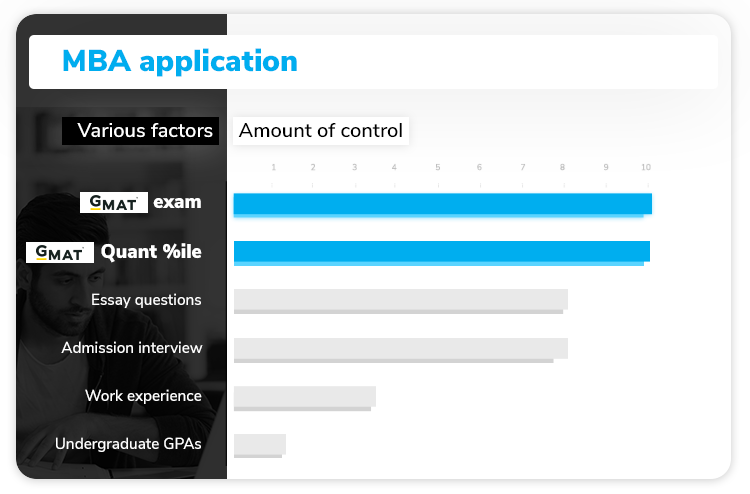
Now comes the question of how to make the best use of this chance; how to best exercise this control. In this article, we will answer this question specifically for Quant and show you how to prepare for a Q50-51. Read this article to find a similar plan of action for success in GMAT Verbal.
Read this article to find a similar plan of action for success in GMAT Verbal.
Now, if you are someone who is already at a high score but struggling to get to that next level (in other words, you have plateaued!), then this article should definitely be important for you. But what if you are someone who is at a low Quant score right now? Will this article still be beneficial for you?
Absolutely! This article works for both kinds of students – those who want to go from good to great scores (Q46 to Q51), as well as those who want to go from average to good to great scores (Q30 to Q46 to Q51).
Absolutely! This article works for both kinds of students – those who want to go from good to great scores (Q46 to Q51), as well as those who want to go from average to good to great scores (Q30 to Q46 to Q51).
When should you take the GMAT?
Selecting the right GMAT test date is crucial for your GMAT quant preparation. It’s important to find a date that gives you enough time to thoroughly review and practice all the math concepts tested on the GMAT. To help you with this, we’ve created a quiz that will provide you with personalized recommendations on the best test date for you. Our quiz takes into account your current level of preparation and your target score to suggest the most suitable test date for you. So, take a few minutes to complete the quiz and gain valuable insights that will help you achieve success on the GMAT!
Through this article, we will answer the three most important questions on the right way to get to that coveted Q50-Q51 score in a predictable manner- after all, who would like surprises here? (Although, I know you’d say that good surprises are always welcome) 🙂

These three questions are:
- How to prepare for a high Quant score?
- What are the metrics to track progress in your journey to the Q51?
- How to overcome the Q48/Q49 plateau?
Together, these three questions will help you understand all you need to hit a home run on GMAT Quant (and not just swing, connect and pray for the best). First, you will learn how to prepare for success the right way, with powerful, actionable steps that form a part of the ladder to your GMAT success. Next will be how to track the right metrics, to know that you are going in the correct direction, and to know if you really are making progress. This will ensure that if you are not preparing the right way, then you don’t just find that out at the end – 2 days away from your exam; instead, you find it out well in time to be able to fix things. Finally, all of you who successfully reached close to the perfect score but do not where that final leg of improvement will come from will find their answer here.
Okay, I’m sure you’re all pumped up to get to these answers now. We are, too! But before you start learning how to reach a Q51, you need to know what really is a Q51. Read on and first find out what it even means to score a Q51.
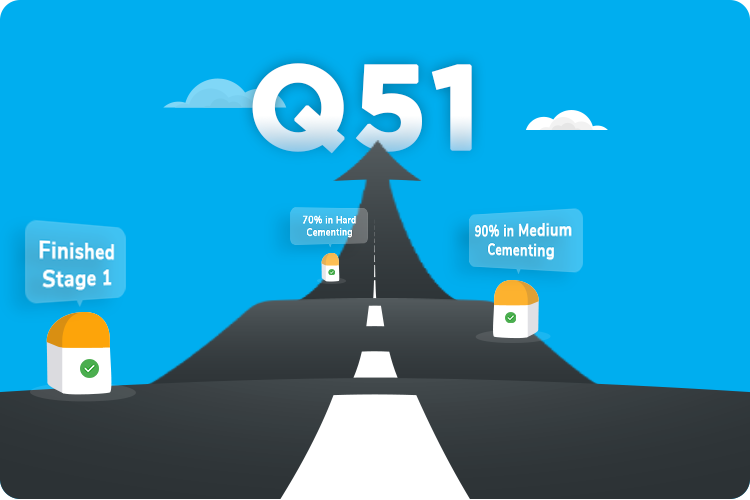
1. What does a Q51 represent?
Now comes the question – “what all do I need to be perfect on? Is there a list of the most “important” topics that will be enough to make me the right level of perfect?”
Contrary to popular perception, a Q51 is not the perfect score that comes only with perfect accuracy. You do NOT have to get each question correct to get a Q51. But yes, it still does mean being almost perfect. Now comes the question – “what all do I need to be perfect on? Is there a list of the most “important” topics that will be enough to make me the right level of perfect?”
Well, first you need to know that a Q50/51 is representative of the fact that you can solve both medium and hard questions on the exam with extremely high precision; again, remember that you need to be almost perfect. Now, on the GMAT, being perfect overall can only happen if you are perfect in the constituent parts. So, you need to hit home runs in both the sub-sections of GMAT Quant- Arithmetic and Algebra/Geometry, to really make it on the big game, the full exam. The deep dive doesn’t end here. These two sections together test over a hundred important subtopics and concepts, such as Prime Numbers, Divisibility, Absolute Values, Inequalities, Permutations and Combinations, Probability, etc. And then, on top of it, a Q51 is not just about concepts; it is also about knowing how to use process skills to apply these concepts. For a quick list, here are the 7 process skills that must be mastered to make that Q51 a reality: Translate, Infer, Simplify, All Cases, Constraints, Visualize, and Manipulate.
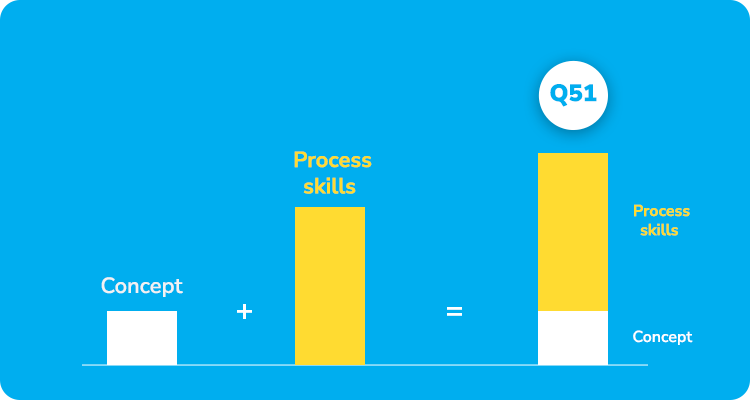
We don’t mean to scare you, but we really want you to know why a Q51 has its prestige – it takes hard work, and given the extent of concepts and application skills to be mastered, you would agree when we say that it takes structured hard work.
Scoring a Q51 is not just about knowing concepts; it is also about knowing how to use process skills to apply these concepts
2. What gives us credibility?
In case you’re wondering why you should trust us with this critical aspect of your MBA dream, let us give you some background. For starters, all that you are going to learn here has already powered thousands of GMAT Quant successes for e-GMATers (Our students!). Our Quant course offering, Quant 2.0 has delivered the highest number of Q49+ scores reported on GMAT Club since its launch. Oh, and by the way, these are not just people with high starting abilities.
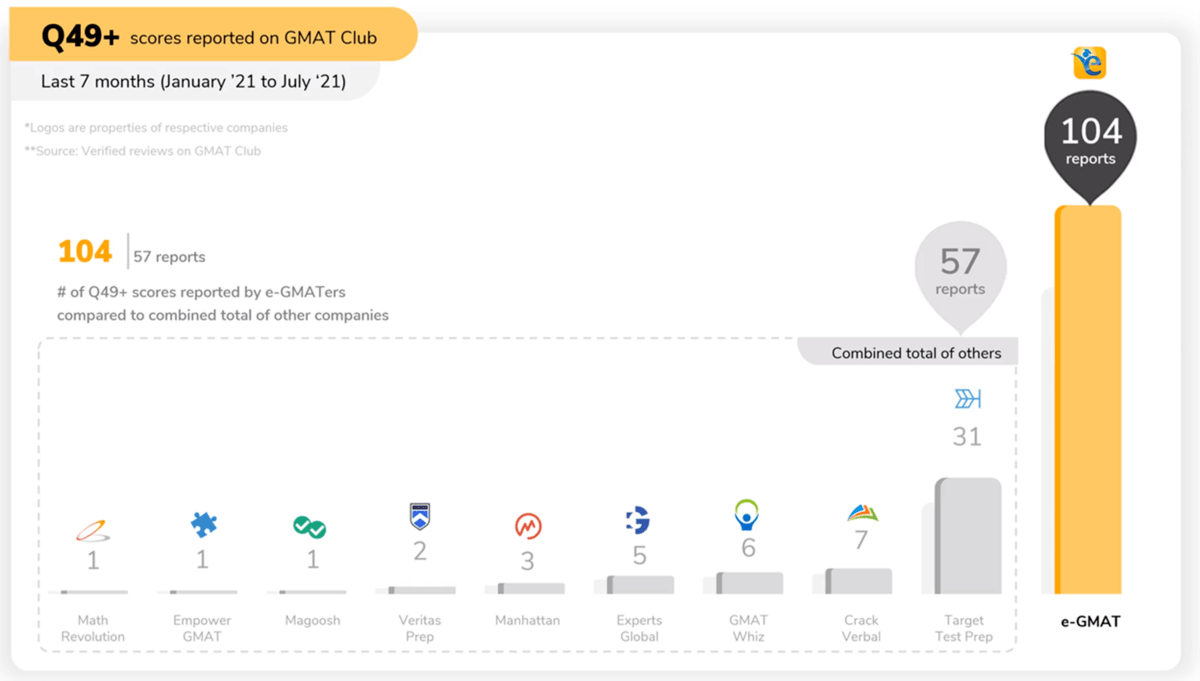
For example, Rida, who was scared of Quant after a not-so-comfortable history at school, improved from a Q33 to a Q49; whereas Richa, who already had some ground covered through her education until then, went from a Q38 to a Q50. Both students got to their dream scores despite starting from very different points, 15th and 35th percentiles, respectively. In fact, Rida liked the product so much that she interviewed with us and now works with us!
Trust in us and motivation for yourself in place, let’s now finally start answering the core questions mentioned at the top and get you on the path to your success!
3. How to prepare for a Q51?
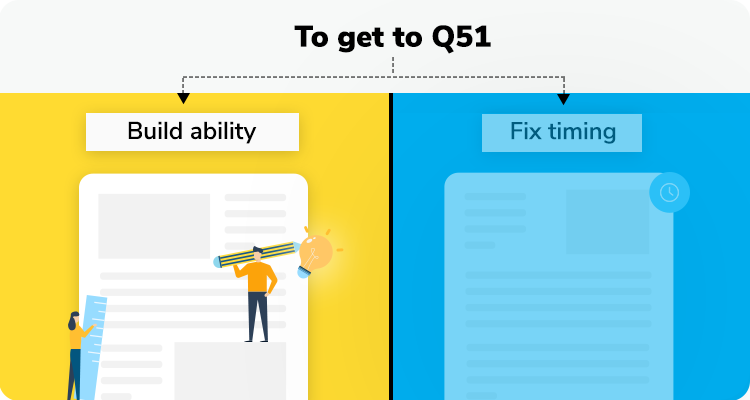
First, let’s set the fundamentals straight. For all of you, no matter what your starting abilities, the most efficient way to prepare to get to a Q51 is to focus on building ability first and then worry about timing.
We’re stating this right upfront so that while reading the steps ahead, you don’t have your mind burdened with a later-stage concern- timing. In this article here, we will talk thoroughly about building ability.
Now, let’s get down to some actionable steps. We’re going to break the entire process down into four major steps:
- Find your exact starting points
- Master one topic at a time
- Cement
- Refine to Perfection
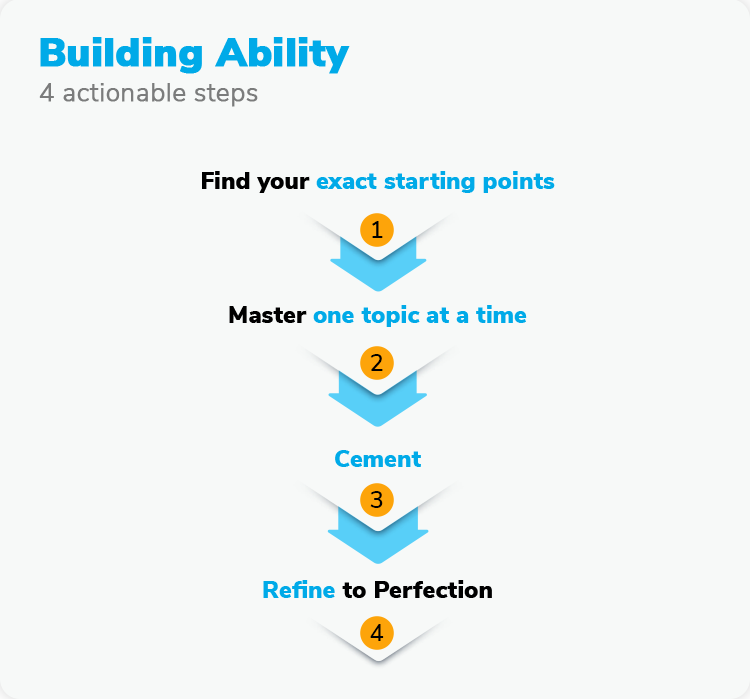
3.1 Step 1: Find your exact starting points
What and Why?
Let’s think for a minute about how we find the route from one place to another. We open your go-to maps app on our phone, enter our current location, our desired destination, and voila – we have a path to follow.
The situation is not very different when it comes to GMAT Quant prep. You need to go from your current Quant score to your desired Quant score. But there is one critical difference – your overall Quant score is not enough to properly define your starting point.
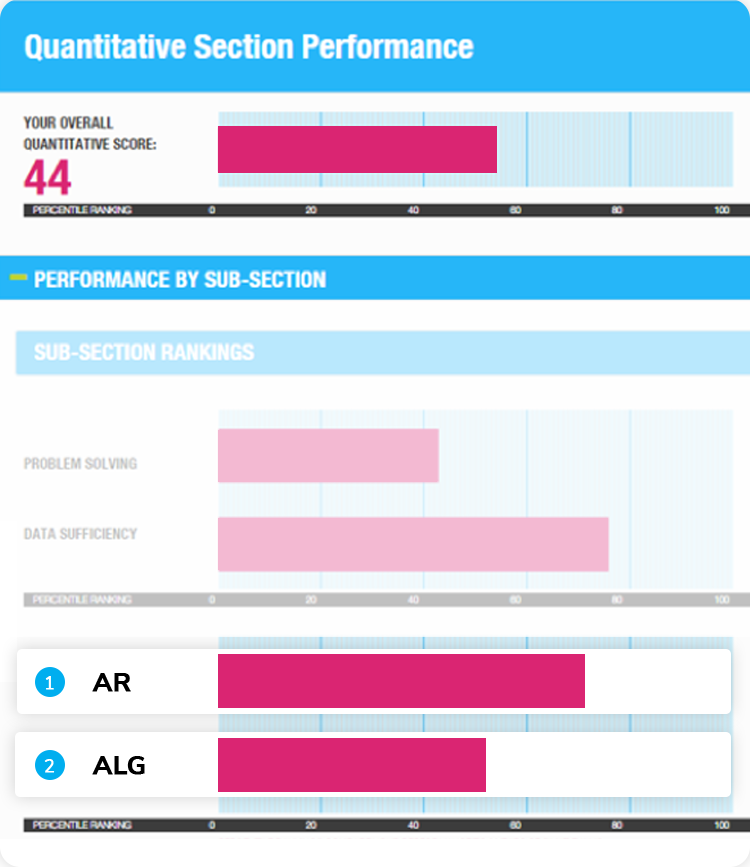
Recall how Quant on the GMAT is divided into two main sub-sections, Arithmetic and Algebra/Geometry. The ESR (Enhanced Score Report) that you get, on a separate purchase, post your GMAT, shows that you get separate scores for both these sub-sections that end up contributing to the overall score. These two subsections can be further subdivided into 5 topics – Number Properties, Word Problems, Advanced Topics, Algebra, and Geometry. So, you should consider mastering Quant as excelling in both the subsections and hence, ultimately in all 5 of the major topics we listed above.
Now, visualize this hypothetical situation. Suppose you found out through a reliable source (more on that below) that you are weak at Algebra and strong at Arithmetic, while your friend found out the reverse. He is super weak at Arithmetic but is strong at Algebra. Now, you try to answer this: Will both of you prepare the exact same way? Same level of focus in each sub-section? I hope you’ve realized by now that the correct answer to these is NO.
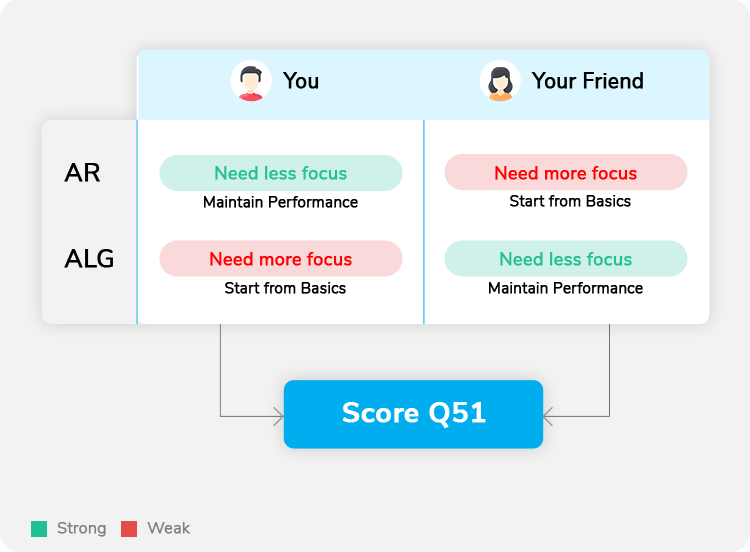
Depending on your starting scores at the sub-sectional level, you need to customize your preparation – pay more attention to the weaker area because you NEED to ace both subsections for a Q51 (always remember this!). Overall, though your destination is the same, but because your starting points are different, your journey will also be different. The key to success is to define the journey that is apt for you.
Overall, though your destination is the same, because your starting points are different, your journey will also be different.
3.1.1 How do I get my starting abilities?
There are only two ways for you to get your starting abilities in this level of detail. Either take the actual GMAT exam and buy the ESR for about $300 in all or take a free Sigma X-mock on the e-GMAT website. The Sigma X-mock is the world’s only mock that gives you ability scores at the sub-sectional level- Arithmetic and Algebra/Geometry.
Fun fact: Even the official mocks by GMAC do not have this level of detail. Wait, we’re not done yet. A Sigma X-mock also gives you these:
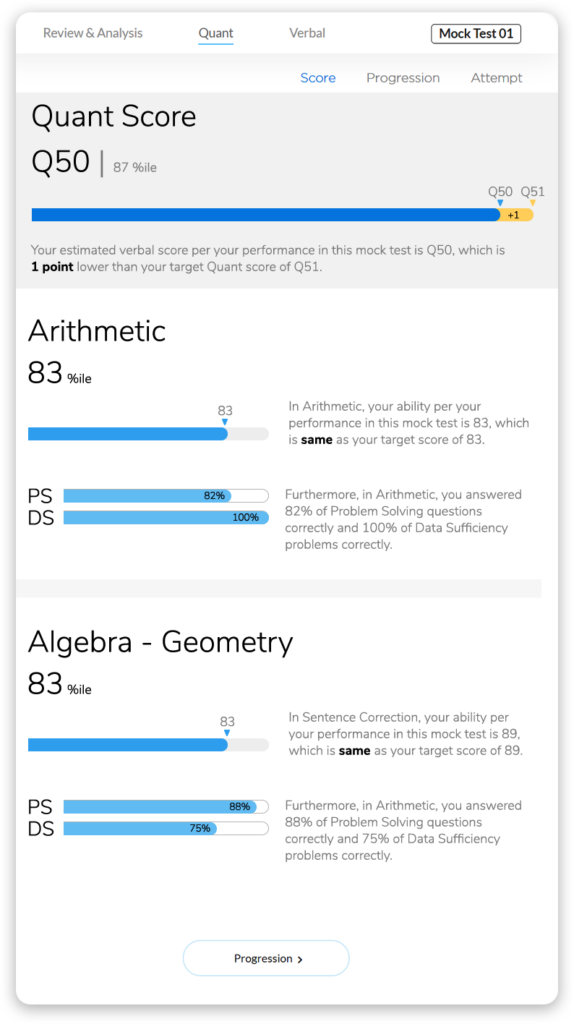
- Progression charts that tell you how you performed as the test progressed, mainly as time kept going and difficulty levels of questions changed. These charts yield insights about timing aspects.
- Did timing have an impact on your accuracy?
- This data is highly valuable in helping you understand your test taking behaviors.
- For example: Do you tend to get the first few questions correct because you spend too much time on them? Do you often get the last few questions wrong because you didn’t have enough time left?
- Did timing have an impact on your accuracy?
- PS/DS Accuracy: This is where you get accuracy data split by the two types of Quant questions – Problem Solving (PS) and Data Sufficiency (DS).
- This data helps you find out if there is any special effort that you need to put into mastering one of these two types of questions.
- Time spent per question: For each question that you solve, you get the exact time you spent on it and not just that – Based on the data we’ve analyzed from thousands and thousands of mocks, you will also see whether the time you spent on each question was optimal, too less, or too high.
To avoid going into too much detail here, we are just linking this article on ALL that a Sigma X-mock captures and the value that each piece of data adds to your success journey, for you to read later.
Now, say you took either of the two, the actual exam or a Sigma X-mock, and you have your starting abilities. Now, it is time for you to:
3.2 Step 2: Understand your optimal path
Your optimal path will obviously depend on where you are today. If your starting score is below Q48, then, most probably, you have significant gaps in at least one of the 5 major topics. In case your score is below a Q45, you are most likely to have gaps in at least 3 out of 5 topics. And finally, if your score is a Q42 or below, it is highly likely that you need to focus on all 5 topics.
What is needed here is for you to identify the topics where you have weaknesses and then fix them. Read Step 3 below for more.
Note: If your score is Q48 or higher, it is very likely that you already know most topics. In this case, you can skip Step 3 and go straight to Step 4, where you will refine your current abilities to perfection.
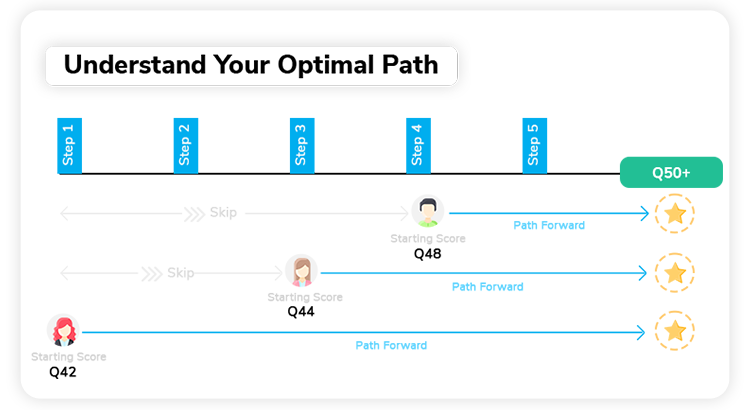
3.3 Step 3: Master one topic at a time
Say Step 1 above has already given you a starting point, and so you now have a list of all your weak topics. What next? Do we just keep studying the concepts in each of them back-to-back and then just do a mock? Not at all! This is how people typically study and so, more often than not, find themselves still far away from their dream score. The trick is to learn and then master one topic at a time.
Thenext thing that you need to now understand is the exact meaning of mastering a topic. When can you say you have mastered any topic? Well, there are just two goals here and if you achieve each one of them, you can claim mastery. Let’s see what they are:
3.3.1 WHAT IS MASTERY
- Building a Solid Conceptual Foundation
Imagine that you were to construct a building. Your first job would be to lay a solid foundation for the building. Else, all that you build above it will soon come tumbling down.
In the context of your GMAT prep, this strong foundation is made of your concepts. If there are any gaps, then fixing them is the first crucial step, without which all that follows will not bear fruit.
- Learning How to Apply these concepts
It’s one thing to know concepts and another to be able to apply them. If you’ve ever said something like “Oh, I know what prime numbers are but the moment I see a question, I go blank”, then you need to work on your application skills.
If we go back to the situation of you constructing the building, one example of learning how to apply is learning how to stack bricks (unless you’re okay with ending up with a leaning wall).
How does one go from Concepts to Application? This is where we need Process Skills, the bridge between concepts and application.
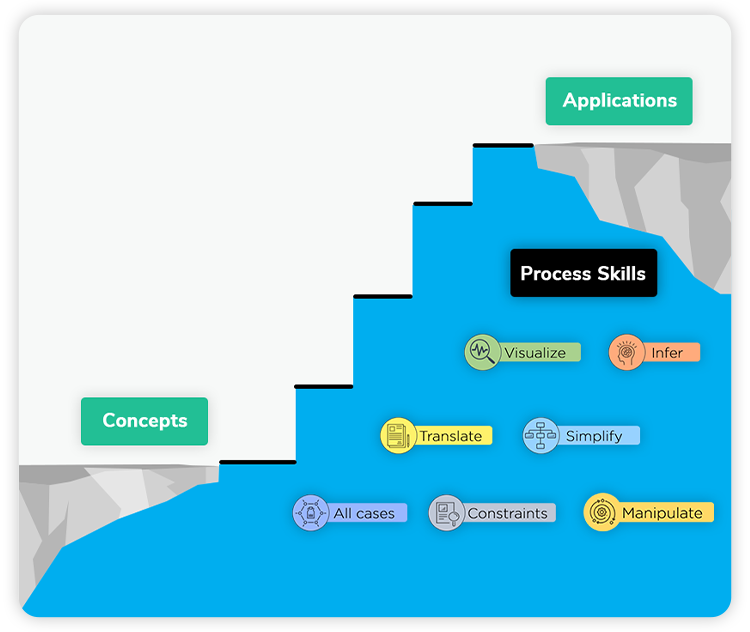
Now, how does one go from Concepts to Application? This is where we need Process Skills, the bridge between concepts and application. All those people who go blank or struggle to apply concepts, this is where they are right now – just hanging on the bridge. The only sure way to successfully cross this bridge and reach the other side is Mastery of all 7 Process skills. These are Translate, Infer, All Cases, Constraints, Visualize, Simplify, and Manipulate.
Watch this series on how to use each of these process skills in effectively solving GMAT-style questions.
Read on to find how to attain this mastery depending on how you are preparing for this prestigious test.
3.3.2 Mastery using books
If you’re preparing through books, then you are your own judge at every point. You need to create your own data to try to find patterns in your mistakes – these patterns might point to either concept gaps or to application gaps. Note that this data needs to be very neatly organized so that you can extract meaningful inferences from it – try an excel sheet with column headers such as “Concepts Missed”, “Skills Missed” (refer to the Process skills playlist we shared earlier!).
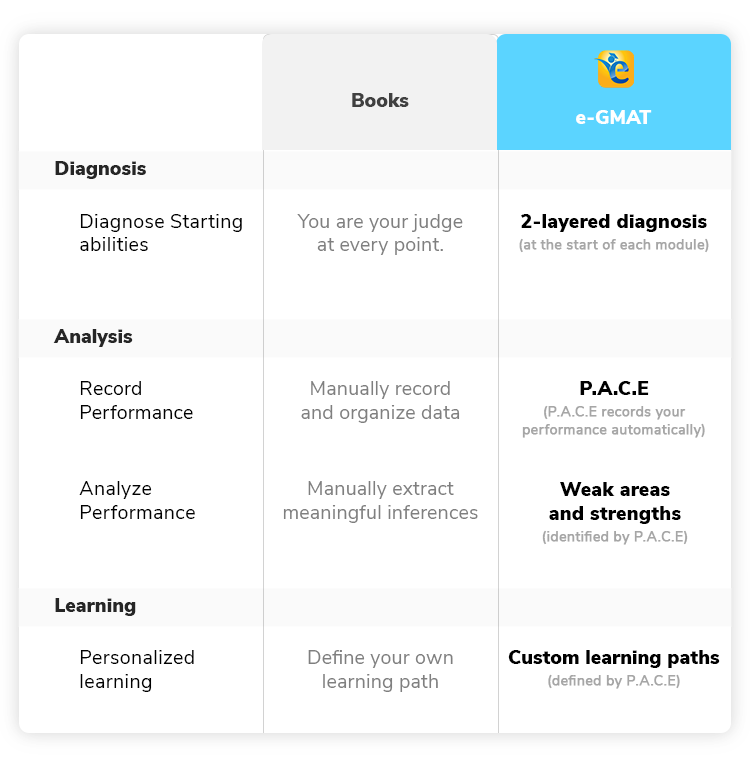
3.3.3 Mastery using the e-GMAT course
If you are an e-GMATer, you already know that you do not need to do any of this analysis on your own. At the beginning of any topic, you first undergo a two-layered diagnosis. This is where you do two diagnostic quizzes – one for concepts alone and one for concepts plus application. Using your performance here, the PACE architecture precisely defines the areas you are thorough with and the ones you need to work on.
No context about PACE?
P.A.C.E (Personalized Adaptive Course Engine), always running in the background, ensures that you learn just enough, not less and not more than you need. This way, you do not just IDENTIFY what gaps to fix but you also get the opportunity to target your effort at your weaker areas by saving time elsewhere. Watch how this student saved over 40 hours of preparation time!
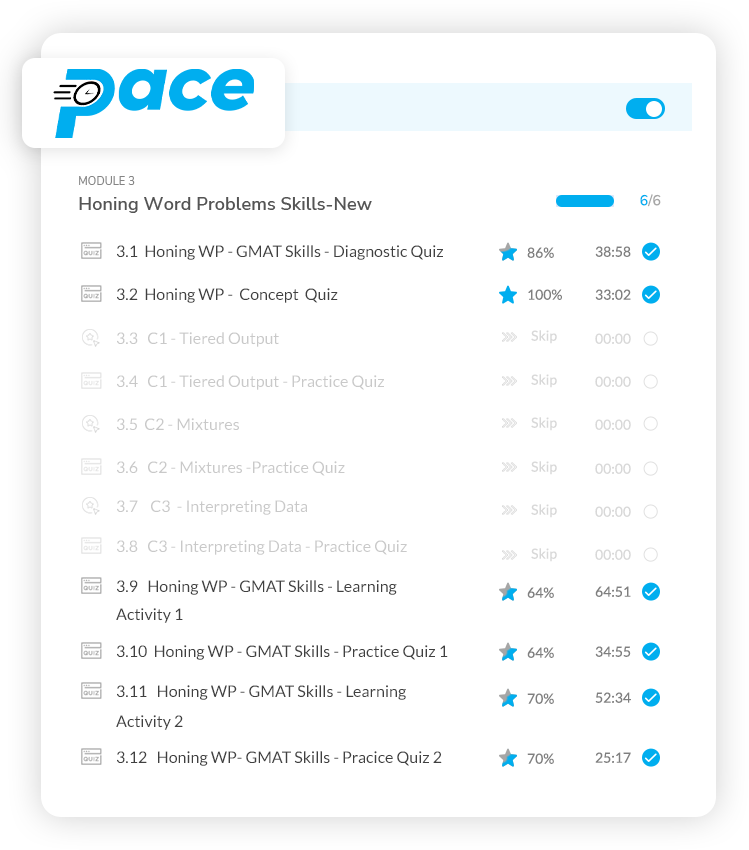
3.4 Step 4: Cement
If you do Step 2 well for any topic, i.e., if you truly master that topic, you can say with confidence that you’ve aced the first stage of learning and with this, you have already gone from Average to Good on that topic. But is that enough for you to move on to the next one? Not if Q51 is the goal you’ve set for yourself.
You have already gone from Average to Good on that topic. But is that enough for you to move on to the next one? Not if Q51 is the goal you’ve set for yourself.
Remember how we said that acing GMAT Quant really comes down to acing all five major topics that fall in the two subsections? We haven’t yet aced the topic we mastered. And so, before you move on to the next one, you need to level up here! You need to upgrade from Good to Very Good. At e-GMAT, this second stage of preparation is called Cementing – here, you “cement” all the foundation you laid in Stage 1.
Just how we had checkpoints to ensure a student had mastered a topic, we have checkpoints here as well to ensure a student has cemented that mastered topic well. These are the metrics you need to hit to pass cementing:
Now again, how to do this stage right depends on how you are preparing. Let me explain how students preparing from different sources can ensure that they pass this very crucial cementing stage.
3.4.1 Cementing using e-GMAT
To cement any topic, e-GMATers have a set of dedicated quizzes, rightly called cementing quizzes. Consider these to be mini mocks- mocks that are topic specific; for example, an Algebra Cementing quiz has questions only from this one topic. But it’s not just a random set of Algebra questions. Each Algebra cementing quiz has representative questions from different sub-topics, such as Inequalities, Absolute Values, etc., in as close a proportion as possible to the actual GMAT.
These cementing quizzes exist both at the medium and the hard level. Also, the way the questions for each quiz are selected ensures that you hit the right metrics, and if you don’t, then you get the right feedback. The structured granularity churns out highly valuable data to help you identify gaps, if any, and overall evaluate whether you have passed cementing for that topic. Once you excel at cementing on any topic, you get so good at it that if the exam only tested this one topic, you would have your Q51.
3.4.2 Cementing using books
If you are someone who is preparing using books, you can still undergo the cementing process. You still need to hit the same metrics to pass cementing. Now, while you can use questions from other books or from the official guides, there are a few things that you will need to take care of. These things will in turn ensure that what you call cementing really does help you become great at that one topic.
You need to ensure all of the following:
- You get questions of the right difficulty level. A medium-tagged question really is medium and one that is tagged hard truly is hard. Without this, your accuracy at these difficulty levels might either be an overestimation or an underestimation.
- You get questions that represent all areas within a topic. So, an Algebra quiz that just has Quadratic and Linear Equations/Inequalities will not really help you judge your exam-readiness for Algebra. If these are your strongest areas, you will score higher than you would on a well-represented quiz; if these are your weakest, you will score lower than on a well-represented quiz.
- You get enough good quality questions. Solve at least 100 questions in total- 50 medium and 50 hard. Just so you know, good quality questions are those that tests the concepts and skills that the GMAT actually tests.
- You have solutions that you can learn from. The life goal of each solution should be to make you better – Better at handling other similar types of questions as well as better in general at approaching questions.
3.5 Step 5: Refine to Perfection
Alright! We are very close to hitting the home run now. You should be able to transition from Good to Very Good in all topics where you do everything till Step 3 nicely. Now, hold tight for the final level-up as you prepare to go from Very Good to Excellent. Either you came till here starting from Step 1 or you are someone who has long been stuck at a very good score – a Q48/49. Read on to see how you can cross this final hurdle (in other words, get out of that plateau that has been bothering you), and rise to success.
Even after cementing, there are some areas where you are not up to the Q51 mark. This is where the power of data comes in to make an unparalleled level of impact.
This stage is all about fine tuning. If you are stuck at a Q48/49, it signifies that even after cementing, there are some areas where you are not up to the Q51 mark. And you know that all weaknesses must be turned into strengths before you finally make it. This is where data comes in to make an unparalleled level of impact. At this point, you leverage analytics to find your areas of weakness. Then, you revise those and plug in all the gaps to leave no space for points to leak out of. Finally, you do dedicated practice on just those areas and end up making them a part of your bucket of strengths.
Let us list the exact steps that will help you comfortably do all of this on the e-GMAT platform:
- Go to the Skill Data tab on Scholaranium.
- In every topic, toggle the medium and hard section to look at accuracy by areas at each difficulty level. Make note of all the areas where your accuracy is below 50%. Here, a low accuracy on medium questions most likely indicates conceptual gaps while a good accuracy on medium but low on hard questions would point to application gaps.
- Reattempt the incorrect questions from these areas by using Scholaranium’s custom quiz engine. Here, you can select not just the main topics but also subtopics that you want to work on, for example, Absolute Values in Algebra. As you do this, also make a careful note of the process skills tested in each of these questions.
- Go back to the course and redo the learning activity files in those areas. These are where you first learn how to apply concepts. Analyze the questions and solutions in these learning activities to understand how the test maker leverages process skills to create questions, and how they add layers of process skills to make basic conceptual questions into GMAT-style questions.
- Come back and practice questions in those areas using Scholaranium’s custom quiz engine. After doing all of the above steps correctly, you will be much better equipped to handle even those areas that started out as weaknesses.
4. Conclusion
Congratulations! We have come a long way from not knowing how to prepare to now knowing even nuanced details as to what to do in case of a score plateau. We still need to bust a common misconception, one that sounds like an obvious truth – that GMAT Quant is a test of Math. The fact of the matter is that GMAT is a test of logic and not Math. You do not need to be naturally good at Math to ace GMAT Quant (We can hear some relieved sighs from all the way here! Happy for you!). Anyone, regardless of their starting point and age, can get a Q50/51 as long as they put in the right effort.
Ultimately, what matters here is not your intelligence but all of the following:
- Whether you started at the right point.
- Whether you put in focused effort.
- Whether you used the right processes to build ability, and
- Whether you refined your abilities to perfection.
Anyone, we repeat anyone, who is methodical, and who perseveres enough can get to a Q51. Just trust yourself and get going!
We wish you a very Happy Learning!















